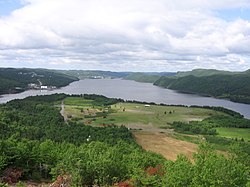 | |
| People | Miꞌkmaq |
|---|---|
| Headquarters | Samiajij Miawpukek |
| Province | Newfoundland and Labrador |
| Land [1] | |
| Reserve(s) | Samiajij Miawpukek |
| Land area | 28.39 km2 |
| Population (2023) [1] | |
| On reserve | 836 |
| On other land | 2 |
| Off reserve | 2263 |
| Total population | 3101 |
| Government [1] | |
| Chief | Brad Benoit |
| Council |
|
| Website | |
| mfngov.ca | |
Samiajij Miawpukek | |
|---|---|
| Samiajij Miawpukek Indian Reserve | |
 | |
| Coordinates: 47°52′0″N55°44′37″W / 47.86667°N 55.74361°W | |
| Country | |
| Province | |
| Settled | 1822 [2] |
| Recognition under the Indian Act | 1987 [2] |
| Government | |
| • Chief | Brad Benoit |
| • Federal MP | Clifford Small (CPC) |
| • Provincial MHA | Elvis Loveless (LIB) |
| Population (2023) | |
• Total | 836 |
| Time zone | UTC-3:30 (Newfoundland Time Zone) |
| Area code | 709 |
| GNBC Code | ACPWX [3] |
| Highways | |
Miawpukek First Nation is a Mi'kmaq First Nations band government in Conne River, Newfoundland and Labrador, Canada, with a registered population of 836 living on-reserve as of May 2023, with another 2,265 living off-reserve. [4] [5] They control the reserve of Samiajij Miawpukek in Bay d'Espoir on the island of Newfoundland. It was formerly known as Conne River Indian Reserve until the mid-1980s. [6] Samiajij Miawpukek was established as a federal Indian reserve in 1987, the first in Newfoundland and Labrador. In 1991, Miawpukek was one of the poorest communities in Atlantic Canada. Due in part to increased education of its members, it has gone on to become the most well-off First Nation in Atlantic Canada after Membertou. [7] [8]
